1: Safety
- Page ID
- 292388
\( \newcommand{\vecs}[1]{\overset { \scriptstyle \rightharpoonup} {\mathbf{#1}} } \)
\( \newcommand{\vecd}[1]{\overset{-\!-\!\rightharpoonup}{\vphantom{a}\smash {#1}}} \)
\( \newcommand{\id}{\mathrm{id}}\) \( \newcommand{\Span}{\mathrm{span}}\)
( \newcommand{\kernel}{\mathrm{null}\,}\) \( \newcommand{\range}{\mathrm{range}\,}\)
\( \newcommand{\RealPart}{\mathrm{Re}}\) \( \newcommand{\ImaginaryPart}{\mathrm{Im}}\)
\( \newcommand{\Argument}{\mathrm{Arg}}\) \( \newcommand{\norm}[1]{\| #1 \|}\)
\( \newcommand{\inner}[2]{\langle #1, #2 \rangle}\)
\( \newcommand{\Span}{\mathrm{span}}\)
\( \newcommand{\id}{\mathrm{id}}\)
\( \newcommand{\Span}{\mathrm{span}}\)
\( \newcommand{\kernel}{\mathrm{null}\,}\)
\( \newcommand{\range}{\mathrm{range}\,}\)
\( \newcommand{\RealPart}{\mathrm{Re}}\)
\( \newcommand{\ImaginaryPart}{\mathrm{Im}}\)
\( \newcommand{\Argument}{\mathrm{Arg}}\)
\( \newcommand{\norm}[1]{\| #1 \|}\)
\( \newcommand{\inner}[2]{\langle #1, #2 \rangle}\)
\( \newcommand{\Span}{\mathrm{span}}\) \( \newcommand{\AA}{\unicode[.8,0]{x212B}}\)
\( \newcommand{\vectorA}[1]{\vec{#1}} % arrow\)
\( \newcommand{\vectorAt}[1]{\vec{\text{#1}}} % arrow\)
\( \newcommand{\vectorB}[1]{\overset { \scriptstyle \rightharpoonup} {\mathbf{#1}} } \)
\( \newcommand{\vectorC}[1]{\textbf{#1}} \)
\( \newcommand{\vectorD}[1]{\overrightarrow{#1}} \)
\( \newcommand{\vectorDt}[1]{\overrightarrow{\text{#1}}} \)
\( \newcommand{\vectE}[1]{\overset{-\!-\!\rightharpoonup}{\vphantom{a}\smash{\mathbf {#1}}}} \)
\( \newcommand{\vecs}[1]{\overset { \scriptstyle \rightharpoonup} {\mathbf{#1}} } \)
\( \newcommand{\vecd}[1]{\overset{-\!-\!\rightharpoonup}{\vphantom{a}\smash {#1}}} \)
\(\newcommand{\avec}{\mathbf a}\) \(\newcommand{\bvec}{\mathbf b}\) \(\newcommand{\cvec}{\mathbf c}\) \(\newcommand{\dvec}{\mathbf d}\) \(\newcommand{\dtil}{\widetilde{\mathbf d}}\) \(\newcommand{\evec}{\mathbf e}\) \(\newcommand{\fvec}{\mathbf f}\) \(\newcommand{\nvec}{\mathbf n}\) \(\newcommand{\pvec}{\mathbf p}\) \(\newcommand{\qvec}{\mathbf q}\) \(\newcommand{\svec}{\mathbf s}\) \(\newcommand{\tvec}{\mathbf t}\) \(\newcommand{\uvec}{\mathbf u}\) \(\newcommand{\vvec}{\mathbf v}\) \(\newcommand{\wvec}{\mathbf w}\) \(\newcommand{\xvec}{\mathbf x}\) \(\newcommand{\yvec}{\mathbf y}\) \(\newcommand{\zvec}{\mathbf z}\) \(\newcommand{\rvec}{\mathbf r}\) \(\newcommand{\mvec}{\mathbf m}\) \(\newcommand{\zerovec}{\mathbf 0}\) \(\newcommand{\onevec}{\mathbf 1}\) \(\newcommand{\real}{\mathbb R}\) \(\newcommand{\twovec}[2]{\left[\begin{array}{r}#1 \\ #2 \end{array}\right]}\) \(\newcommand{\ctwovec}[2]{\left[\begin{array}{c}#1 \\ #2 \end{array}\right]}\) \(\newcommand{\threevec}[3]{\left[\begin{array}{r}#1 \\ #2 \\ #3 \end{array}\right]}\) \(\newcommand{\cthreevec}[3]{\left[\begin{array}{c}#1 \\ #2 \\ #3 \end{array}\right]}\) \(\newcommand{\fourvec}[4]{\left[\begin{array}{r}#1 \\ #2 \\ #3 \\ #4 \end{array}\right]}\) \(\newcommand{\cfourvec}[4]{\left[\begin{array}{c}#1 \\ #2 \\ #3 \\ #4 \end{array}\right]}\) \(\newcommand{\fivevec}[5]{\left[\begin{array}{r}#1 \\ #2 \\ #3 \\ #4 \\ #5 \\ \end{array}\right]}\) \(\newcommand{\cfivevec}[5]{\left[\begin{array}{c}#1 \\ #2 \\ #3 \\ #4 \\ #5 \\ \end{array}\right]}\) \(\newcommand{\mattwo}[4]{\left[\begin{array}{rr}#1 \amp #2 \\ #3 \amp #4 \\ \end{array}\right]}\) \(\newcommand{\laspan}[1]{\text{Span}\{#1\}}\) \(\newcommand{\bcal}{\cal B}\) \(\newcommand{\ccal}{\cal C}\) \(\newcommand{\scal}{\cal S}\) \(\newcommand{\wcal}{\cal W}\) \(\newcommand{\ecal}{\cal E}\) \(\newcommand{\coords}[2]{\left\{#1\right\}_{#2}}\) \(\newcommand{\gray}[1]{\color{gray}{#1}}\) \(\newcommand{\lgray}[1]{\color{lightgray}{#1}}\) \(\newcommand{\rank}{\operatorname{rank}}\) \(\newcommand{\row}{\text{Row}}\) \(\newcommand{\col}{\text{Col}}\) \(\renewcommand{\row}{\text{Row}}\) \(\newcommand{\nul}{\text{Nul}}\) \(\newcommand{\var}{\text{Var}}\) \(\newcommand{\corr}{\text{corr}}\) \(\newcommand{\len}[1]{\left|#1\right|}\) \(\newcommand{\bbar}{\overline{\bvec}}\) \(\newcommand{\bhat}{\widehat{\bvec}}\) \(\newcommand{\bperp}{\bvec^\perp}\) \(\newcommand{\xhat}{\widehat{\xvec}}\) \(\newcommand{\vhat}{\widehat{\vvec}}\) \(\newcommand{\uhat}{\widehat{\uvec}}\) \(\newcommand{\what}{\widehat{\wvec}}\) \(\newcommand{\Sighat}{\widehat{\Sigma}}\) \(\newcommand{\lt}{<}\) \(\newcommand{\gt}{>}\) \(\newcommand{\amp}{&}\) \(\definecolor{fillinmathshade}{gray}{0.9}\)General Information
Chemical Safety is one of the most important topics covered in the general chemistry laboratory. There are multiple goals in the safety curriculum. First are the obvious goals of keeping students safe during the lab and not creating hazards for others. The second is to develop the proper protocols and procedures for performing experimental activities so that when the student enters advanced courses or the work force, they have the skills needed to function in a safe and prudent manner. In fact safety is the biggest complication to running an online lab where students will be working at home, sometimes alone and in their kitchens. But there is another goal for safety, and this deals with safety literacy in the digital age, that is, in this age of instant information, where people can post false claims online, it is important that students develop the skills to evaluate chemical safety information. Thus we will include activities in evaluating online information and the importance of understanding data provenance before assessing the validity of online information. That is, where did you get this data? Is it a valid source, and did it provide a trail for you to further understand where the data came from. We will start this module by looking at the Chemical Hygiene Plan at UALR.
Chemical Hygiene Plan
Every university has a CHP (Chemical Hygiene Plan) as required by OSHA standard 29 CFR 1910.1450 and a CHO (Chemical Hygiene Officer) who is responsible for its implementation, and UALR's CHP can be found at the Facilities Management Web Page. Within the CHP are a set of standard SOPs (Safe Operating Procedures) that represent the minimum safe practices for the handling of hazardous chemicals and operation of equipment (like how to secure a compressed gas tank). Every research lab at the university is required to develop and maintain SOPs for the laboratory practices that are performed within their labs, and here is a link to the template for developing laboratory specific SOPs. The CHP also defines the PPE (Personal Protective Equipment) needed to perform work in a laboratory, and in the university teaching laboratory the instructor would be responsible for ensuring students abide by the established SOPs, and wear proper PPE, like safety glasses and closed toe shoes (no flip-flops in the chemistry laboratory), and do not perform any unauthorized experiments. Unfortunately, it will be impossible for an instructor to ensure students abide by the SOPs in an online course where lab work is being performed remotely, and thus for reasons of safety we will not be able to perform many of the experiments that could be done remotely in a kitchen.
Chemical Safety Resources
Prudent Practices
The National Research Council of the National Academies of Sciences has published a book "Prudent Practices in the Laboratory" that can be downloaded for free and has a wealth of information on chemical safety, including a copy of OSHA's Laboratory Standard (29 CFR 1910.1450). There is also an accompanying zip file of a CD that contains Laboratory Chemical Safety Summaries (LCSS) and additional information.

UN GHS
OSHA's laboratory standard is actually integrated into the United States implementation of the United Nations Globally Harmonized System of Classification and Labeling of Chemicals (GHS) and the 8th edition can be downloaded as a PDF. Within the GHS are the requirements for Safety Data Sheets (SDS) which have superseded the MSDS (Material Safety Data Sheets) that are required for any chemical transported or sold within the US.
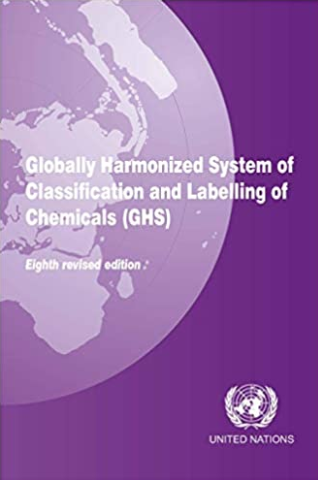

PubChem LCSS
The National Institute of Health's (NIH) National Library of Medicine's (NLM) PubChem have developed LCSS that model the LCSS of the NRC, but extract data from multiple chemical compound databases. As of May 2020 there are LCSS for 141,993 chemical substances that can be obtained through PubChem. This is a very valuable resource for finding safety information on chemicals and it is structured so you can instantly find the source of that information
COVID-19 Pandemic Issues
This course is being taught online because of the COVID-19 pandemic and there is a lot of conflicting information being spread across the internet, which makes it an ideal topic for discussing safety. In fact PPE that are normally used in the lab like masks and face shields are now often required in public. Students are expected to follow CDC guidelines when in public, which includes covering your mouth and nose when in public and it is worth watching this video from Florida Atlantic University and then discussing the kinds of PPE one should use to prevent either contact or air born spread of COVID-19.
Video \(\PageIndex{1}\): https://youtu.be/MMwYsGews-8
In the following video a chemistry professor at UC-Boulder who studies aerosol transmission of COVID-19 discusses the difference between water droplets and aerosols, while the video goes over some of the issues with evaluating online information. Later this semester we will learn more about aerosols, which are an interesting type of mixture called a colloidal dispersion. Aerosols are sort of a like mixture between a liquid and a gas, and the liquid components can absorb many chemical compounds but like a gas, travel great distances. Many so called "gas phase reactions" actually occur in aerosols and this are very important in fields like atmospheric chemistry.
Video \(\PageIndex{2}\): https://youtu.be/Y3zKRHzccMk
On Sep 21, 2020 the above video describes how the CDC posted an alert that the primary mechanism for the spread of COVID-19 was through aerosols and than strangly took that recommendation down saying it was posted in error, which can lead one to wonder what was going on with the CDC? Fast forward to Jan. 19, 2021 and the screen capture below clearly states that aerosols are involved in the spread of COVID-19. The important thing with regards to safety is to get all the information you can, assess where that information is coming from, and then make up your mind. Safety literacy is more than finding information on the web, it is also evaluating that information, and in the case of COVID-19, that could be the difference between life and death.
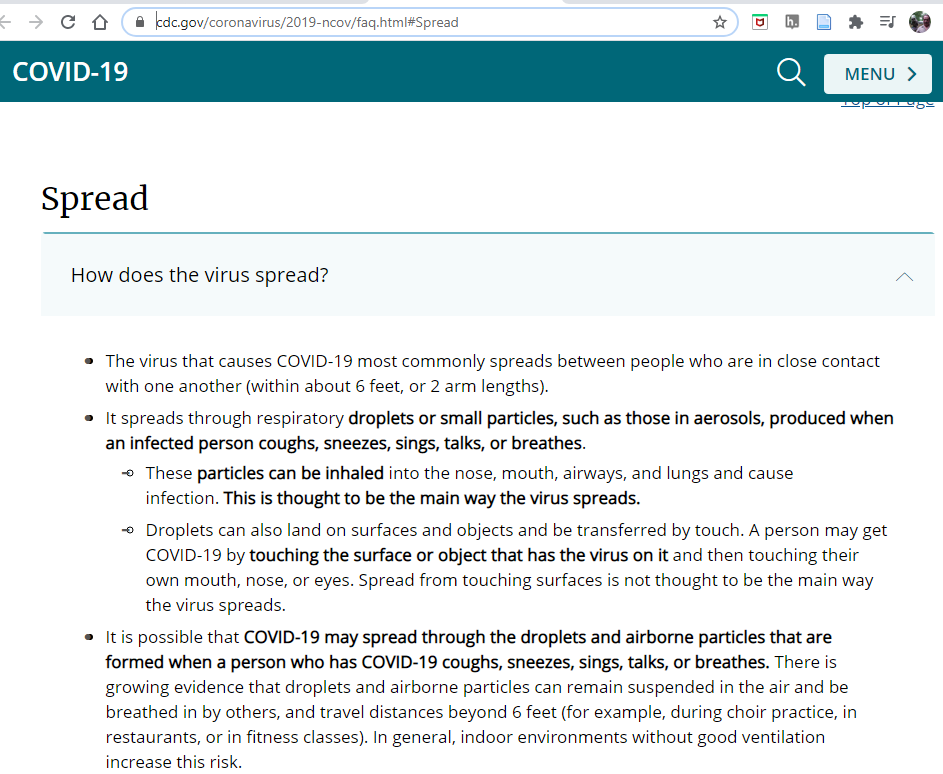
Lab Safety Information
You are required to watch this video and answer the questions of the Safety Video Quiz in Google Classroom (Ancillary Documents). When you're done you will have a few minutes to discuss the answers with your group, but each student must submit what they feel are the best answers.
While this video covers everything you need to know about lab safety, we wanted to show you one of the labs at UALR. Due to COVID-19 you will be taking this class at home, but it is important that you are familiar with the setup for your future labs.
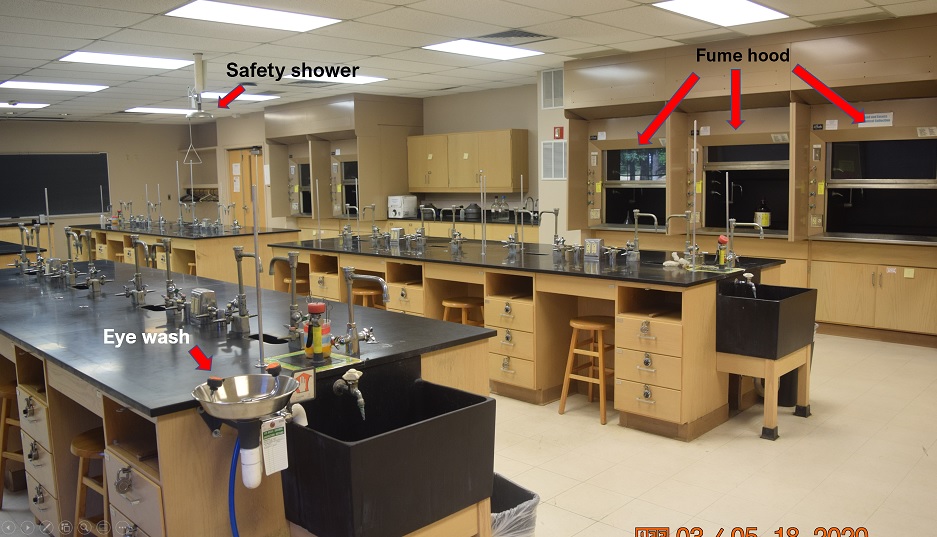
Let's take a closer look at the eyewash. To operate the eye wash open the dust covers and push the handle located immediately to the right from it. Just in case some debris has settled on the water spout you should always flush out the water from the nozzle before flushing your eye with it.
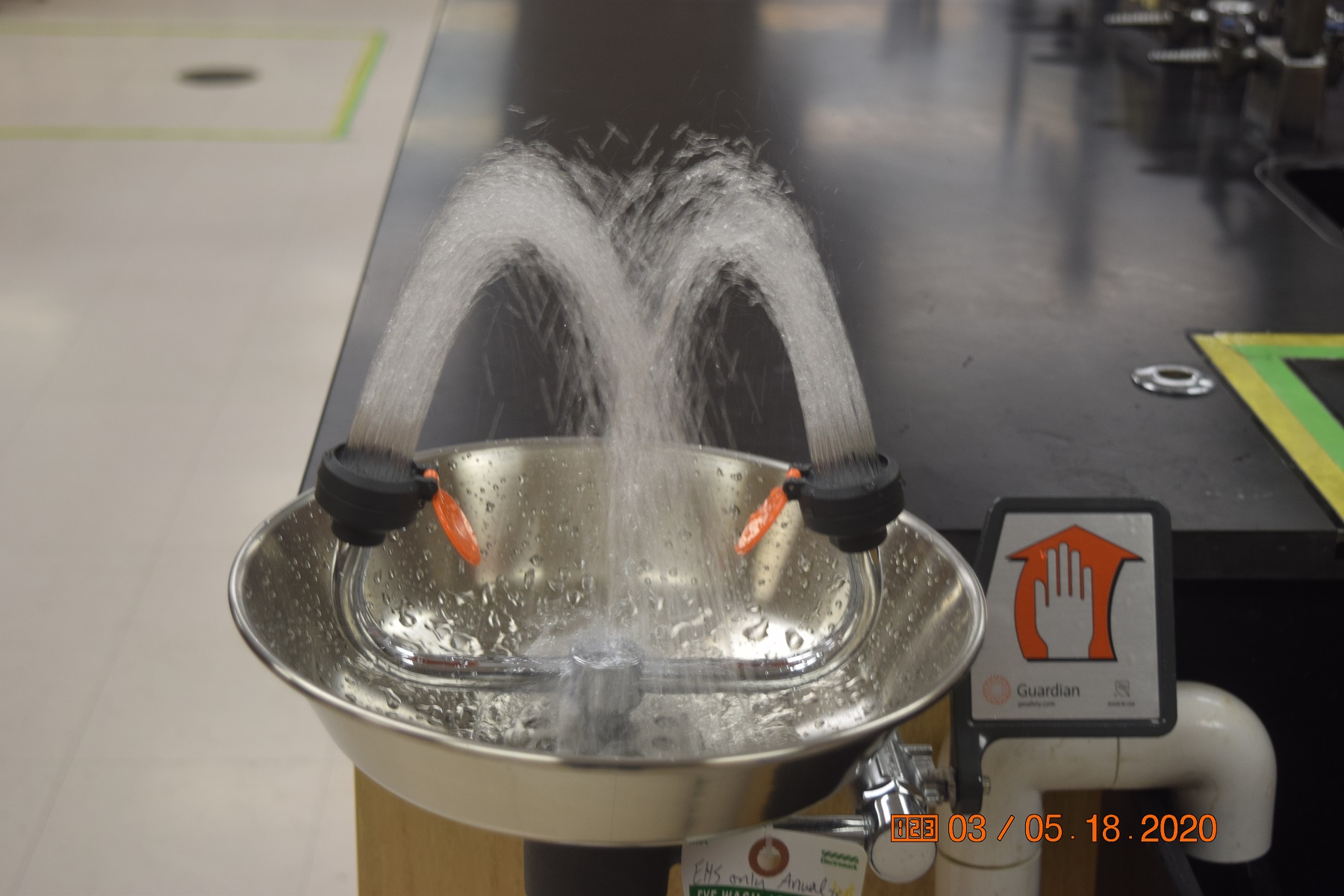
When you start working in a lab make sure you know where all the safety equipment is located and how to use it.


Always remember to dispose of chemicals in the way indicated in your lab manual. In the lab you will find waste jars labeled for each experiment.
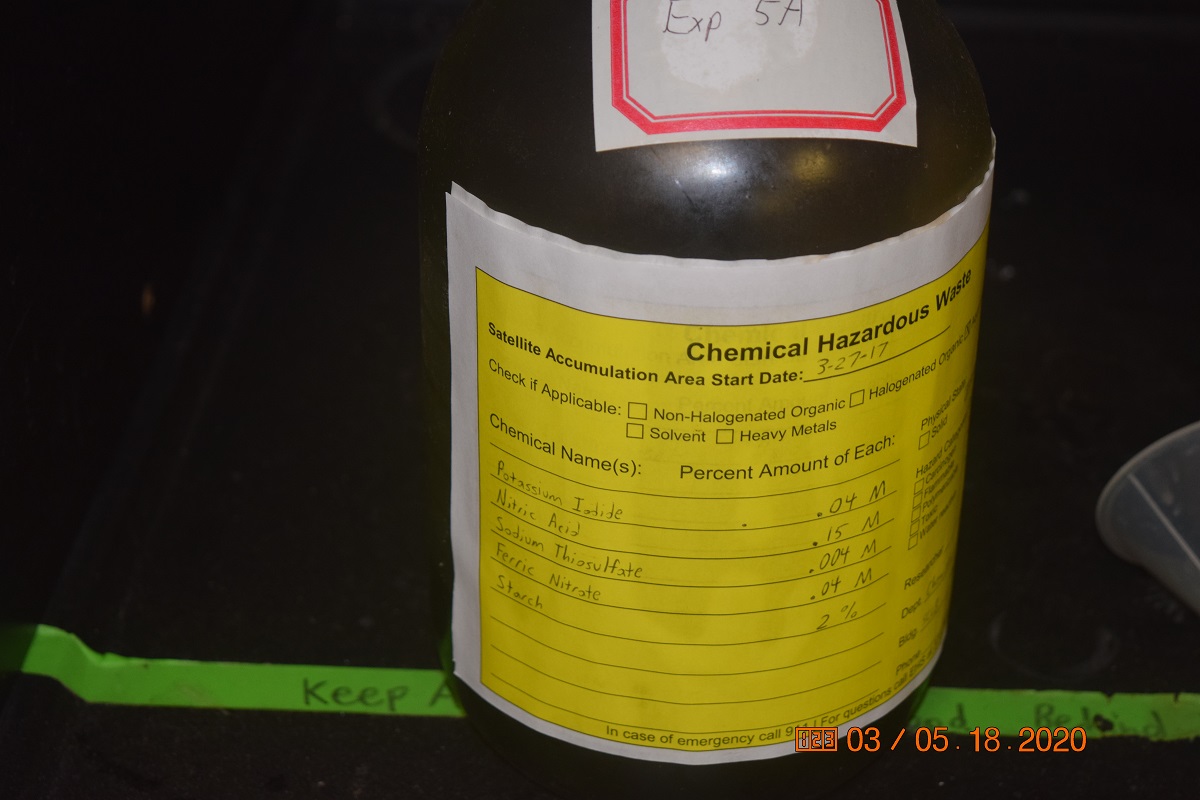
Always remember to ask your instructor if you're not sure about something!
Now Go to Google Classroom and Do Assignment 1B: Safety Quiz
Lab Assignments
For this lab we will be using Google Classroom. If you already familiar with it - great! If not, don't worry, it is very easy to navigate. You will have individual and group assignments. You can learn more about each type below. There are specific requirements for this lab and certain instructions that you have to follow. Your instructor has sent you a link that allows you to join the classroom, and you can then open your UALR email, click on the Google Apps, scroll down to Classroom, and you have access to your lab classroom.

Assignment 1A: Group Form
Before Opening your Google Classroom and doing assignment 1A you should watch this 2:15 minute video "Working Alone in the Lab", and what you need to realize is that although you are working as a group, it is really a virtual group and some of you may actually be alone. Thus it is important that you turn on your cameras and get to know each other, and how to contact each other in case an accident occurs during the lab.
\(\PageIndex{3}\): 2:15 second YouTube created by the American Chemical Society on working Alone in the Lab (https://youtu.be/Y8DBd45W4hY).
Now go to Google Classroom and open the assignment 1.A: Group Form
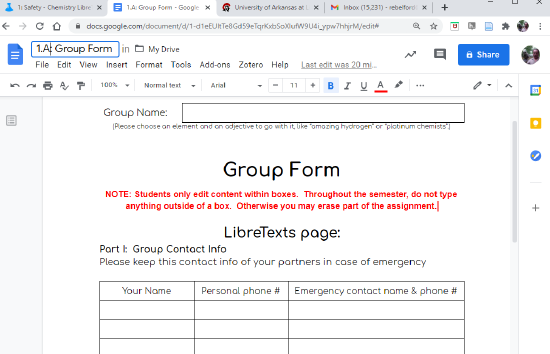
Once you fill out this form you need to submit it as a Group Assignment. The instructions for doing this are below in section 1.3.1 of this lab
Assignment 1.B Safety Literacy
This is a group assignment to be done during the lab. In this assignment you will study SDS for potassium permanganate and discover there is what appears to be conflicting information, but if you look deeper, you will figure the information is not really conflicting. You need to go to your Google classroom to do this assignment. You will submit this as a group assignment.

Assignment 1.C: Individual Work
Go to the Google Classroom and do the Quiz 1C: Individual Work. You may discuss this with other students, but each student must submit their own answer. Each student must write their own unique essays. If students submit identical essays they will split the points. So if 5 students have identical essay the maximum score is 20%.

Figure \(\PageIndex{7}\): Screen capture image of Individual Quiz, each student must submit their own response by the deadline, this quiz can be obtained in Google Classroom
Uploading to Google Classroom
There are several options, some assignments will be collaboratively authored (Group Assignments) and other individually.
Submitting Group Assignments
This describes how you submit a Google Doc that you collaboratively authored.
- Open the Group Assignment in Google Classroom
- Locate the attached Google Doc under the description and open it
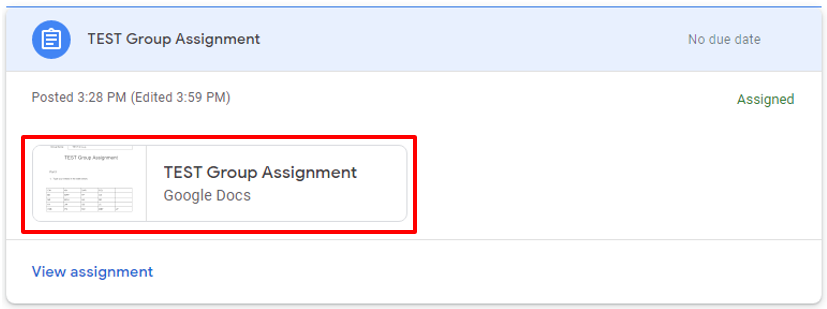
Figure \(\PageIndex{13}\): Open the Google Doc - Work with your teammates to complete the assignment
- If you had closed the assignment in Google classroom you need to reopen it and click on "View Assignment", if it is till open and you see \(\PageIndex{5}\) you may skip this step, and proceed to step 5.

Figure \(\PageIndex{14}\): To open the assignment click on "View Assignment" - Mark your assignment as Done. You do not need to attach any documents.

Figure \(\PageIndex{15}\): Mark your assignment as Done - You will see a warning. Continue by clicking on "Mark as done"
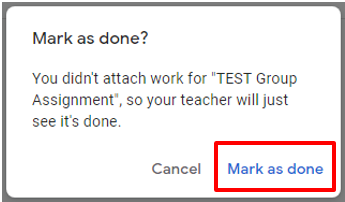
Figure \(\PageIndex{16}\): Warning messag
Attention: EACH student has to mark their assignment as done to receive credit.
Contributors and Attributions
Robert E. Belford (University of Arkansas Little Rock; Department of Chemistry). The breadth, depth and veracity of this work is the responsibility of Robert E. Belford, rebelford@ualr.edu. You should contact him if you have any concerns. This material has both original contributions, and content built upon prior contributions of the LibreTexts Community and other resources, including but not limited to:
- Elena Lisitsyna

